You are here
Olympic National Park Overview | Olympic Coast | Lake Quinault Rain Forest and Enchanted Valley | Queets and Hoh Rain Forest | Sol Duc River Valley | Lake Crescent Area | Elwha River Valley | Hurricane Ridge Area | Deer Park | Eastern Valleys and Hood Canal Area | Staircase and Hood Canal Area | Campgrounds and Lodging | Backpacking, Shuttles, and Climbing Mount Olympus | Pets
Olympic National Park Overview
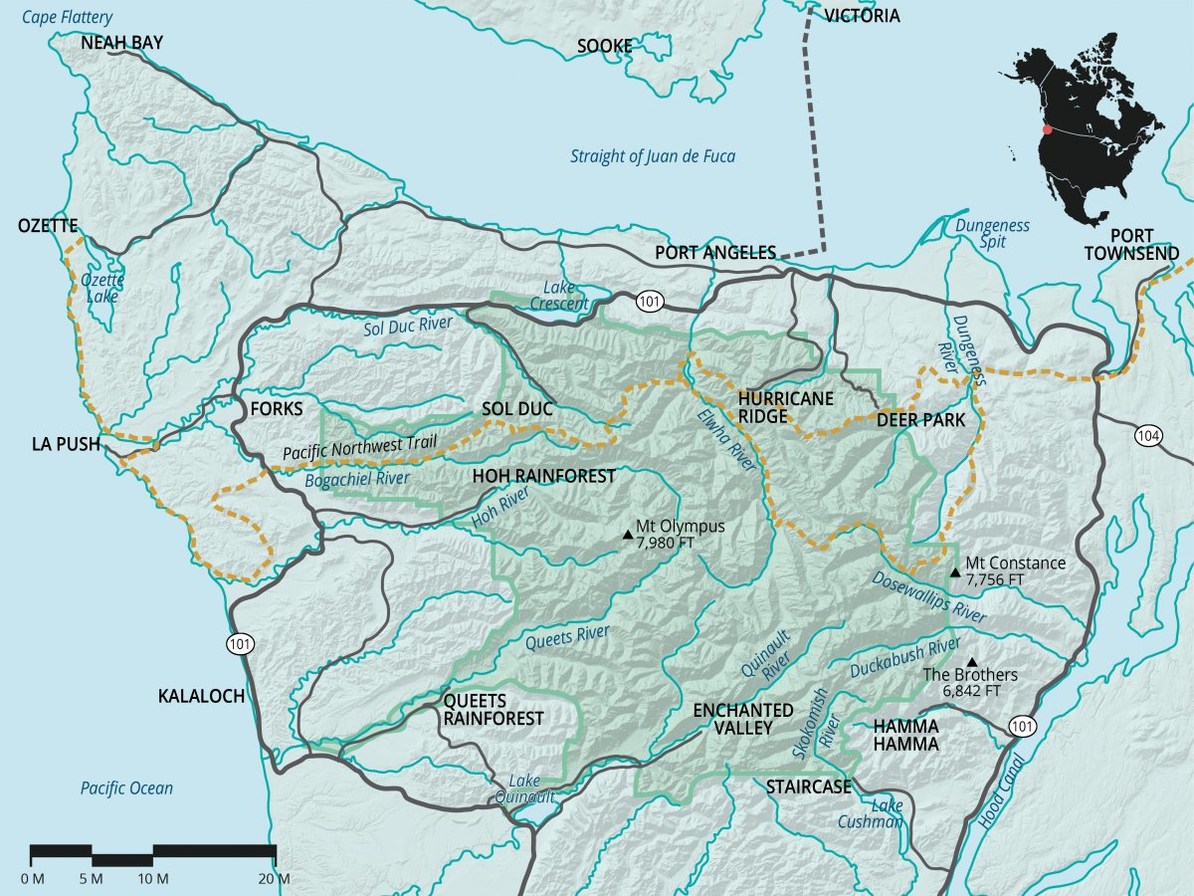
Verdant, jagged, wind-scoured, wave-worn, sandy, glaciated, saturated, and above all, absolutely stunning, Olympic National Park sits at the northwestern tip of the contiguous United States like a portal. Move back in time and walk beside gnarled giants through a stand of old-growth cedar and hemlock; stand with a thumping heart and burning legs on an alpine ridge overlooking the Strait of Juan de Fuca; sink into miles of sand as you pack your way around tide pools, sea stacks, and petroglyphs. The variety of this national park is astounding, and those who have the patience and the diligence to explore any portion of the nearly 1 million acres of wild area will find moving natural experiences everywhere.
First recognized as a national monument by President Theodore Roosevelt as early as 1909, it was President Franklin Roosevelt who established the area as Olympic National Park in 1938. This essential protection definitively resolved the rancorous contest between the Forest Service, which represented the logging interests in the area, and tourists and environmentalists who saw this section of the Olympic Peninsula as a timeless gift. In one account of President Franklin Roosevelt's historic tour that led to the park's designation, the Forest Service actually moved signs to disguise the fact that clearcuts were afoot on federal land; the ruse was discovered later. The national park designation arrested a management strategy based on resource extraction that would have decimated timber stands and watersheds. In contrast to this prioritization of short-term economic gains, consider that Olympic National Park was the fifth-most visited National Park in the country in 2010, or that there were 3.2 million visitors in 2014, or that since its inception, more than 154 million people have visited the park.
Ask any fan of Olympic National Park to talk about the area, and it is only a matter of time before the word "diversity" tumbles off their lips. Coastal zones, alpine zones, temperate rainforests, and dry forests in the eastern rain shadow all lie within the park's boundaries. The geology and climate of the Olympic Peninsula allow for a bioregional diversity that is unique for such a concentrated area. Unlike the volcanism that has created the Cascades, the Olympics were born on the ocean floor and rose through subduction: as an older and colder oceanic plate was forced under a newer, warmer North American plate, the upper portion of the oceanic plate was shaved off and backed up into itself as a disorganized pile of mountains. Much, much later, intense glaciation created the Strait of Juan de Fuca to the north and the Puget Sound to the east. The evolution of endemic animal species such as the Olympic marmot and plant species such as the Flett's violet indicate that, with aquatic borders to the west, north, and east, an island-like ecology functioned following the ice age.
The ecology of the peninsula has also developed in conjunction with a remarkably wet climate. Moist Pacific storms blow into the wall of the Olympic Range with persistence and force, triggering enormous amounts of precipitation annually. The rivers and streams that flow from the high areas of the park swell with snowmelt and rain as they rush to the ocean or the strait, and the temperate rainforest becomes a thick, thriving biomass. While the saturated sections of the park are more well known, it's interesting to note that a good portion of the park sits in the correlating rain shadow east of the Olympic Range. Thus, while some sections west of the range may receive 150 inches of rain annually, areas east may only see 15 inches per year.
Olympic Coast
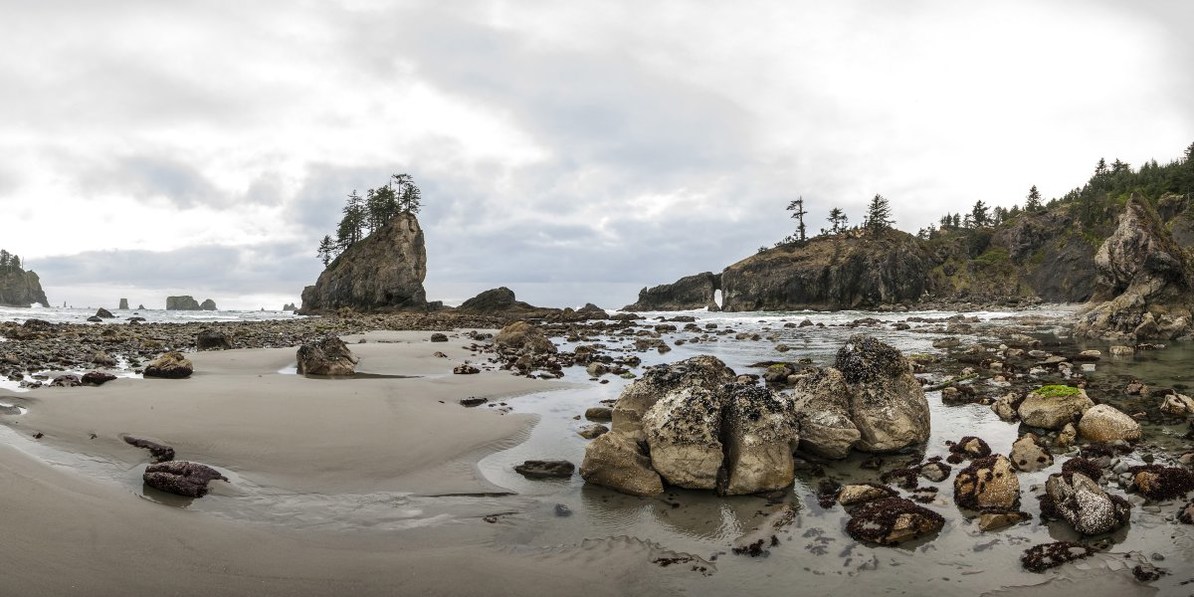
Second Beach. Photo by Tyson Gillard.
The famed Olympic Coast is home some of the most undeveloped stretches of coastline in the United States outside of Alaska. Of the 73 miles of coastline protected in the park, nearly 40 miles is completely undeveloped. Here, isolated and iconic stacks have eroded away from the shoreline, marine life takes hold in countless tide pools, and old-growth western redcedar and sitka spruce tower above the lonely sand. It is also home to the Quillayute National Wildlife Refuge and the Olympic Coast National Marine Sanctuary. From south to north the Olympic Coast includes:
Kalaloch Coast: Stretching from Quinault Indian Reservation all the way north to Ruby Beach, the Kalaloch portion of the coast is the most developed ... a relative term for this remote section of the U.S. Notable adventures include:
- Kalaloch Beach
- Beach 4 (tide pools)
- Beach 6
- Ruby Beach
- Kalaloch Big Cedar Tree + Grove
- Campgrounds: South Beach Campground, Kalaloch Campground.
- Lodging: Kalaloch Lodge.
Hoh River to La Push: This 17.5-mile undeveloped stretch of coastline is only accessible by foot and is broken up by sea stacks, dramatic headlands, and six backcountry campsites. Notable adventures just south of La Push include:
- First Beach (surfing)
- Second Beach (1.4 miles there-and-back, tide pools)
- Third Beach (2.8 miles there-and-back)
- Giants Graveyard Hike (8.8 miles there-and-back)
La Push to Ozette: You won't find any roads, gas stations or motels in this 21-mile stretch of coastline, only crabs, bald eagles, green anemones, and purple sea stars, all of which makes for excellent backpacking. Notable adventures include:
- Rialto Beach
- Hole-in-the-Wall (3.0 miles there-and-back, tide pools)
- Campgrounds: Mora Campground.
Ozette: Hosts several trails, including the popular Ozette Triangle Loop, a ranger station, several campgrounds, and it is distinguished by also being the location of Washington's second largest natural lake. Adventures include:
- Ozette Lake
- Ozette Triangle Loop (9.5-mile loop)
- Sand Point Hike (6.0 miles there-and-back)
- Campgrounds: Ozette Campground, Lost Resort Campground
- Lodging: Lost Resort
Ozette to Shi Shi Beach: Extremely remote, this northernmost 9-mile section adjoins the Makah Indian Reservation and features the prominent Point of the Arches. Undeveloped, this section can be through-hiked or done as a there-and-back backpacking trip.
Lake Quinault Rain Forest and Enchanted Valley

Fall at Pony Bridge along the Enchanted Valley Trail. Photo by Gerard Smith.
With up to 12 feet of rainfall annually, the Quinault River Valley, which opens to the Pacific Ocean in the park's southwestern corner, is home to a collection of the largest trees in the United States outside of the redwoods and sequoias of California. The valley hosts the world's largest western hemlock, Alaska yellow cedar, western redcedar (Lake Quinault Big Cedar), and sitka spruce (Quinault Giant Sitka Spruce), and it has a Douglas fir which ties for world's largest. Simply put, things in this very wet temperate climate grow very well, and with the exception of a few summer months, any visitor should expect plenty of rainfall. Many of the valley's exceptional attractions that lie on the lake's southern shore are technically outside the protection of the national park, but they are no less worthy of a visit. Additional adventures include:
- Enchanted Valley to Pony Bridge Hike (5.0 miles there-and-back)
- Enchanted Valley to Enchanted Valley Chalet Backpacking (27 miles there-and-back)
- Enchanged Valley to Anderson Glacier Backpacking (40 miles there-and-back, summer only)
- Colonel Bob Peak Hike (12 miles there-and-back, 4,300-foot elevation gain, summer only)
- Quinault Rain Forest Nature Trail Loop (0.5-mile loop)
- Gatton Creek Falls Loop (2.9-mile loop, massive Douglas firs)
- Campgrounds: Graves Creek Campground, Falls Creek Campground, Gatton Creek Campground, and Willaby Creek Campground.
- Lodging: Lake Quinault Lodge, Lake Quinault Resort.
Queets and Hoh Rain Forest
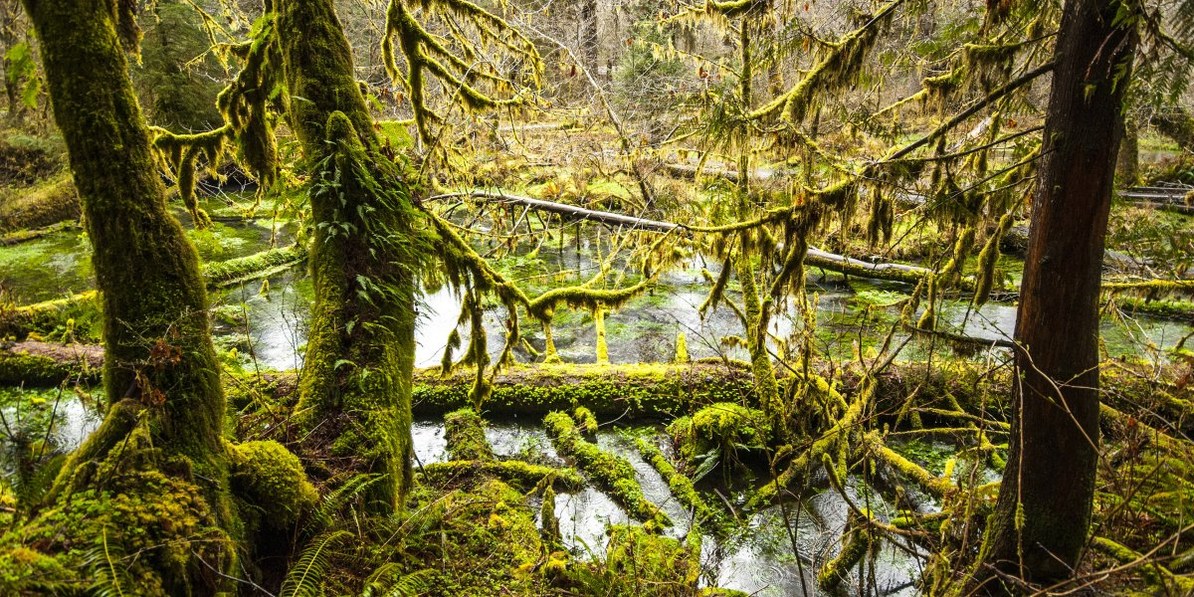
Hoh River Rainforest near the visitor center. Photo by Tyson Gillard.
No place in the lower 48 states is wetter than the three main river valleys of the Olympic Mountain's western slope: the Quinault River, Queets River, and Hoh River Valley. In fact, temperate vegetation thrives so well in this moist climate that these three valleys are home to some of the densest forests in the world in terms of biomass. Not only will you find massive conifers, you'll also find the most diverse collection of moss species in the world. Nowhere is this more apparent than on the easily accessible hikes in the Hoh Rain Forest. Far less touted than the Hoh, the Queets River Valley is one of the park's most remote and least visited areas. Difficult to access, the Queets River Valley is well worth a visit, particularly if you like to avoid crowds. It's also home to one of the world's largest Douglas firs (tied with the one off of the Gatton Creek Falls Loop). Notable adventures include:
- Hoh Rain Forest, Hall of Moss Trail (0.8 mile loop)
- Hoh Rain Forest, Sikta Nature Trail (1.3 mile loop)
- Hoh Rain Forest Big Sitka Spruce
- Hoh River Trail to Five Mile Island Backpacking
- Hoh to Sol Duc via High Divide Trail Backpacking (26 miles one way, 4,900-foot elevation gain, shuttle required)
- Hoh River Fishing
- Mount Olympus (45 miles there-and-back, 7,400-foot elevation gain, summer only)
- Sams River Trail (3.0-mile loop)
- Queets Spruce
- Queets River Trail to Spruce Bottom (summer only due to river ford)
- Campgrounds: Hoh Campground, Hoh Oxbow Campground, and Queets Campground.
Sol Duc River Valley
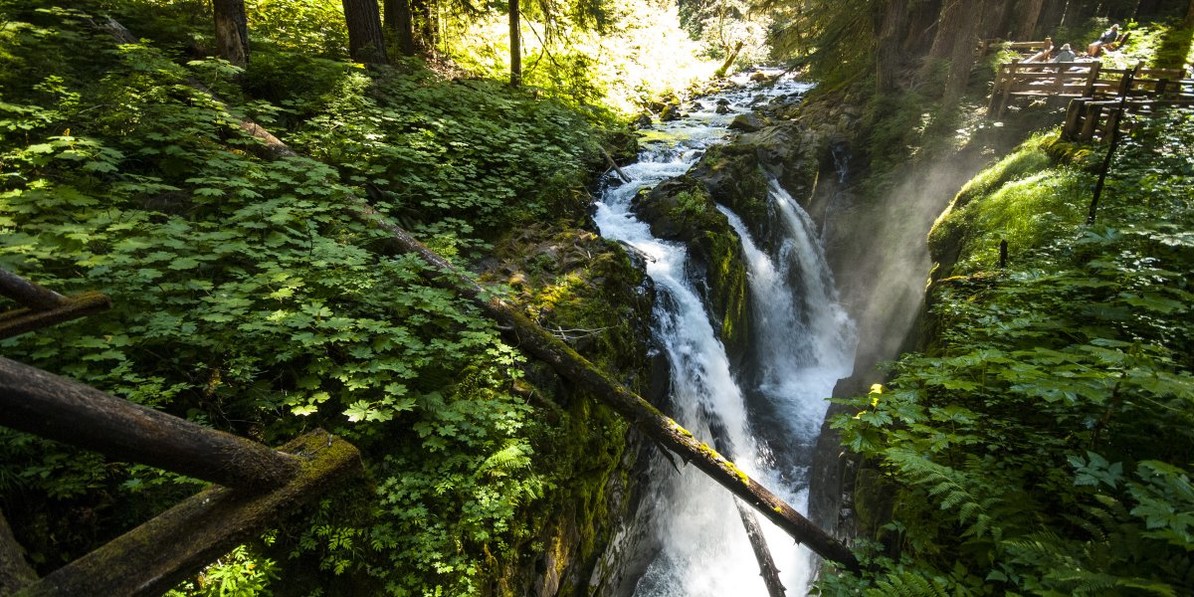
Sol Duc Fall. Photo by Tyson Gillard.
Flowing from the northwest corner of the Olympic Mountains to the Pacific Ocean, the Sol Duc River has been a popular travel destination ever since early settlers discovered the hot springs deep in the valley in the early 1880s. Today the hot springs are completely developed, but they still draw visitors from afar, and they're still definitely worth a relaxing soak. The Sol Duc area is also one of the park's best gateways into the pristine alpine ecosystem. Notable adventures include:
- Sol Duc Hot Springs
- Sol Duc Falls
- Deer Lake Hike (6.8 miles there-and-back, 1,640-foot elevation gain)
- Bogachiel Peak via Deer Lake (16 miles there-and-back, 3,450-foot elevation gain)
- Mink Lakes Hike (8.6 miles there-and-back, 1,500-foot elevation gain)
- High Divide Loop Trail (18-mile loop, 3,500-foot elevation gain)
- High Divide to Hoh River Backpack (26 miles one way, 4,900-foot elevation gain, shuttle required)
- Sol Duc River Salmon Cascades
- Campgrounds: Sol Duc Campground
- Overflow Campgrounds: Klahowya Campground
- Lodging: Sol Duc Hot Springs Resort
Lake Crescent Area
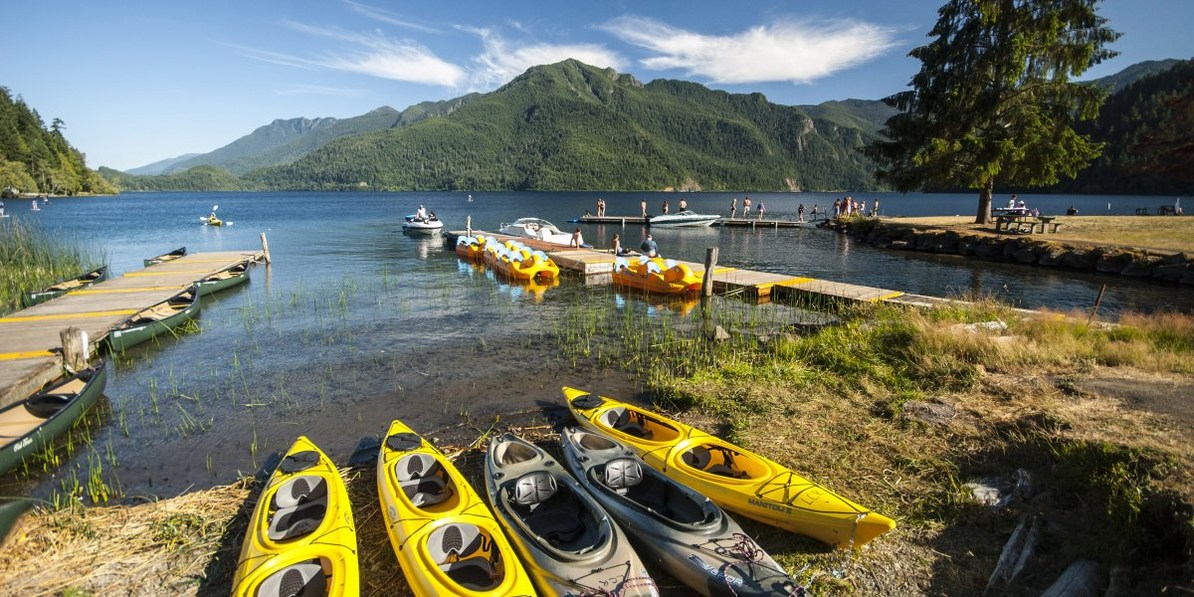
Docks along the shoreline of Lake Crescent at Log Cabin Resort. Photo by Tyson Gillard.
With a depth of 624 feet, Lake Crescent is Washington's second deepest lake after Lake Chelan, and it is also one of the park's most popular recreation areas. Attractions abound around the entire perimeter of this glacially-carved lake, and mountain peaks rise as much as 4,000 feet above the water. Most notably, the historic Lake Crescent Lodge on the lake's southeast shore serves as the starting point for many visitor excursions. Key adventures in the area include:
- Paddling Lake Crescent
- Beaches and swimming areas: Fairholme, Lake Crescent Lodge, La Poel, and East Beach
- Pyramid Peak Trail (7.0 miles there-and-back, 2,400-foot elevation gain)
- Spruce Railroad Trail (8.0 miles there-and-back)
- Barnes Creek Trail (6.0 miles there-and-back, 800-foot elevation gain)
- Moments in Time Interpretive Trail (0.5-mile loop)
- Marymere Falls Trail (1.8 miles there-and-back, 500-foot elevation gain)
- Mount Storm King Trail (4.4 miles there-and-back, 2,000-foot elevation gain)
- Campgrounds: Fairholme Campground, Log Cabin Resort Campground
- Overflow Campgrounds: Lyre River Campground, Salt Creek Recreation Area Campground
- Lodging: Lake Crescent Lodge and Log Cabin Resort
Elwha River Valley
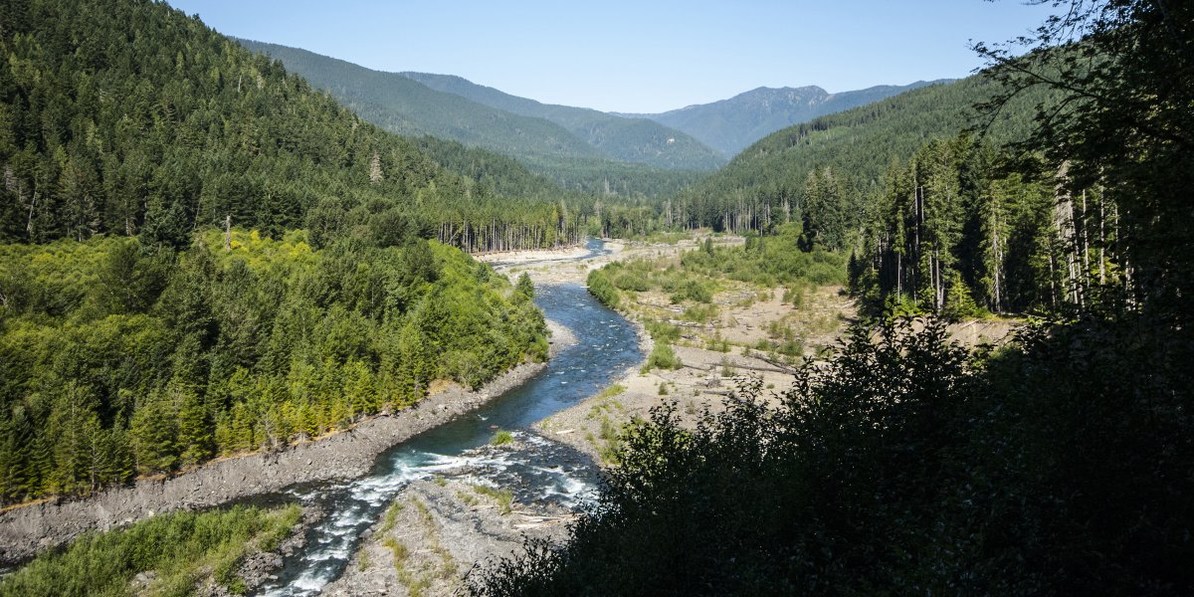
Elwha River looking north. Photo by Tyson Gillard.
The Elwha River was brought into the national limelight with the removal of the Elwha and Glines Canyon dams that lasted from 2011 through 2014. This removal was both a historic milestone for environmental protection and the largest dam removal project ever. The project received more attention after the release of the documentary DamNation. Flowing north from deep in the Olympic Mountains to the Strait of Juan de Fuca, the Elwha River originally attracted environmental attention because it provides spawning grounds for all five species of Pacific salmon (chinook, coho, chum, sockeye, and pink). An adventure into the Elwha River Valley is an opportunity to experience true wilderness. Notable adventures in the area include:
- Happy Lake Ridge Trail Loop (15.6-mile loop, 3,900-foot elevation gain)
- Boulder Hot Springs (also known as Olympic Hot Springs, 4.8 miles there-and-back)
- Madison Falls
- Cascade Rock Interpretive Trail (4.2 miles there-and-back, 1,300-foot elevation gain)
- West Elwha Trail Hike (5.6 miles there-and-back)
- Griff Creek Trail (5.8 miles there-and-back, 2,900-foot elevation gain)
- Wolf Creek Trail to Hurricane Ridge (16 miles there-and-back, 3,900-foot elevation gain)
- Elwha River Trail + Goblin Gates Loop Hike (6.2-mile loop, 720-foot elevation gain)
- Dodger Point Lookout Tower Backpacking (28 miles there-and-back, 4,980-foot elevation gain)
- Elwha River Trail to Hayes River Backpacking (32 miles there-and-back)
- Campgrounds: Elwha Campground and Altair Campground
Hurricane Ridge Area
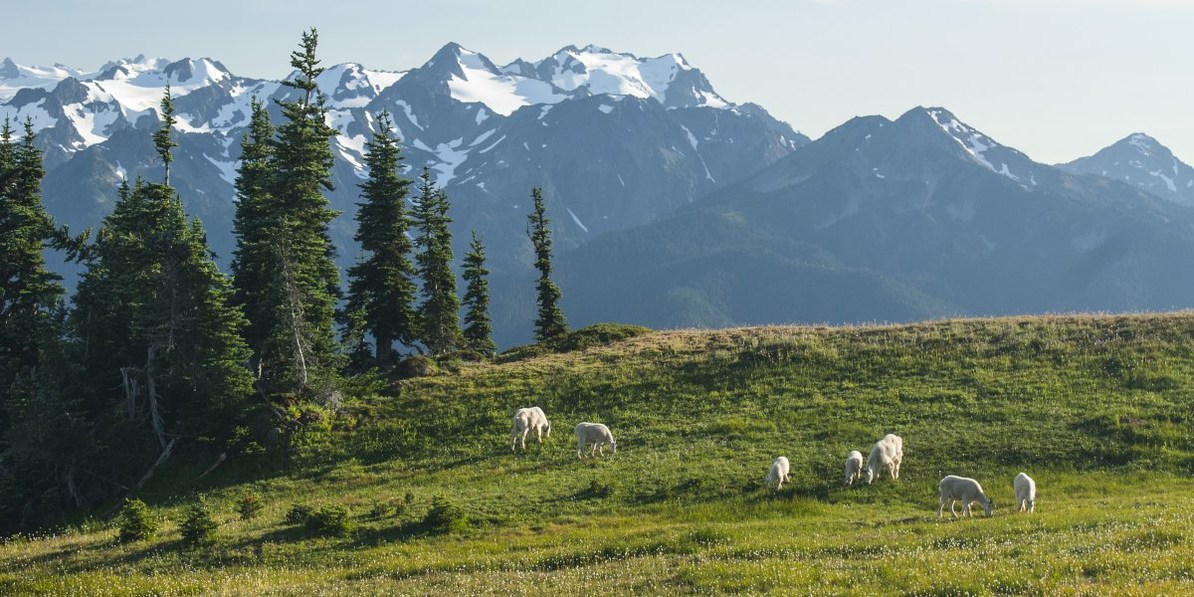
View of Mount Olympus from Hurricane Hill with mountain goats in the foreground. Photo by Tyson Gillard.
Olympic National Park's most popular destination, Hurricane Ridge is perched nearly 4,000 feet above the Elwha River and commands 360-degree views of the entire Olympic Mountain Range, including 7,980-foot Mount Olympus. At 5,200 feet, visitors to Hurricane Ridge can experience a stunning subalpine wilderness without the arduous planning and sweat of a multi-mile hike. The fact that you can essentially drive to the top of a mountain is indeed what makes the Hurricane Ridge area so attractive, but is also what can produce overwhelming crowds during the summer months. The access road is open year round, making the area popular for snowshoeing and cross-country skiing, though winter access is only from 9 a.m. to dusk on Fridays, Saturdays, Sundays, and holiday Mondays. Great adventures in the area include:
- Hurricane Ridge Visitor Center
- Klahhane Ridge + Sunrise Point (5.6 miles there-and-back, 540-foot elevation gain)
- Klahhane Ridge Trail to Rocky Peak/Lake Angeles (9.6 miles there-and-back, 950-foot elevation gain)
- Hurricane Hill Hike (3.0 miles there-and-back, 950-foot elevation gain)
- Hurricane Hill Snowshoing (4.6 miles there-and-back, 1,130-foot elevation gain)
- Mount Angeles via Switchback Trail (4.6 miles there-and-back, 2,050-foot elevation gain)
- Obstruction Point to Moose Lake Backpacking (16 miles there-and-back/loop, 2,460-foot elevation gain)
- Heart O' the Forest (Lake Creek Trail) (4.6 miles there-and-back, 860-foot elevation gain)
- Campgrounds: Heart O' the Hills Campground
- Overflow Campgrounds: Dungeness Recreation Area Campground
Deer Park
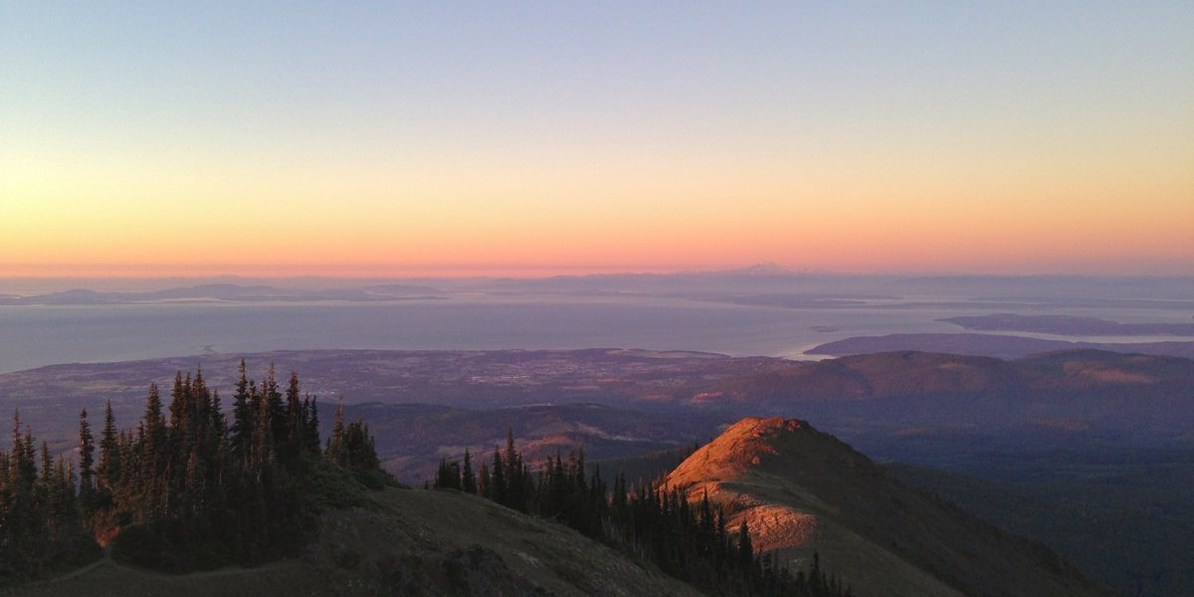
View looking northeast toward Mount Baker (10,781') from the summit of Blue Mountain. Photo by Brent Uhrig.
Ideally, Deer Park is a quieter and higher version of the crowd-filled Hurricane Ridge Area. Here, Deer Park Road leads to subalpine 6,010-foot Blue Mountain, which was once home to a rope-tow ski area. Adventures include:
- Blue Mountain, Rain Shadow Loop Trail (0.5-mile loop)
- Maiden Peak Hike (6.4 miles there-and-back, 810-foot elevation gain)
- Grand Pass Loop
- Campgrounds: Deer Park Campground
Eastern Valleys and Hood Canal Area
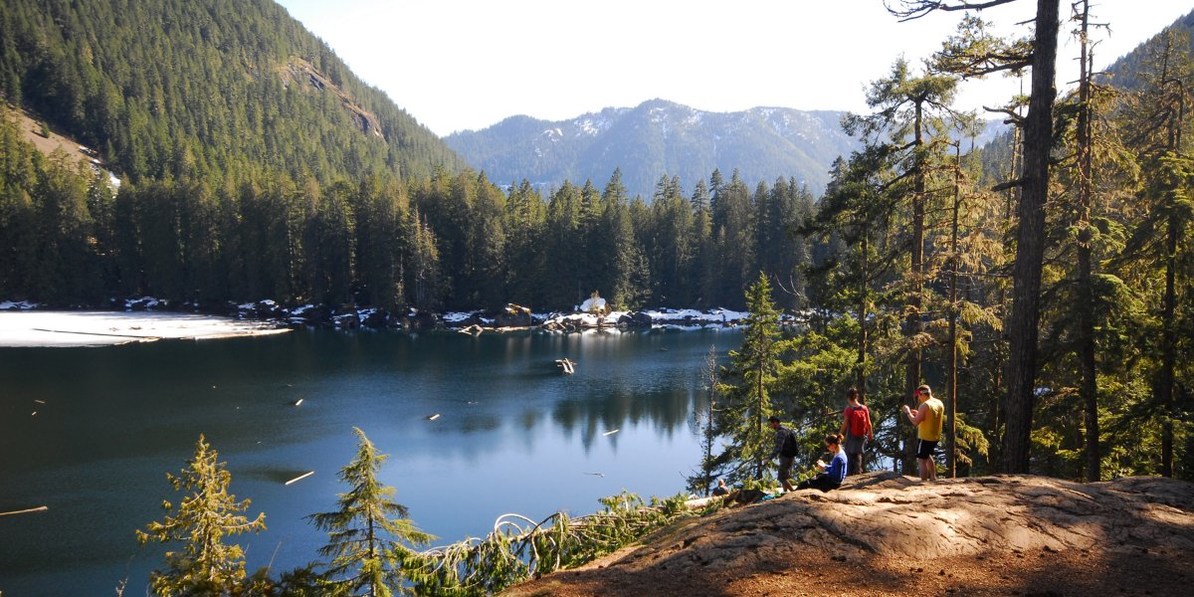
Lena Lake in the Hamma Hamma River Valley. Photo by Tyson Gillard.
With few accommodations and roadside attractions, the deep eastern river valleys of Olympic National Park are relatively calm in comparison to other parts of the park, making them a backpackers paradise. Here, Cameron Creek, Royal Creek, Gray Wolf River, and Dungeness River flow into Dungeness Bay, while Dosewallips River, Duckabush River and the Hamma Hamma River flow gently into the Puget Sound's Hood Canal. The east side also contains the Buckhorn, Brothers Wilderness Area and the Mount Skokomish Wilderness Area, both of which lie just outside the park boundaries but are no less rugged or worthy of exploration. Popular treks from north to south include:
- Cameron Pass via Cameron Creek (36 miles there-and-back, 4,000-foot elevation gain)
- Gray Wolf Pass via Gray Wolf River (36 miles there-and-back, 3,980-foot elevation gain)
- Royal Lake Hike + Ski Basin Tour (16 miles there-and-back, 2,650-foot elevation gain)
- Mount Townsend (8.0 miles there-and-back, 3,010-foot elevation gain)
- Buckhorn Mountain (mountaineering)
- Marmot Pass via Upper Big Quilcene River Trail (11.5 miles there-and-back, 3,490-foot elevation gain)
- West Fork Dosewallips River to Anderson Pass (32 miles there-and-back, 3,860-foot elevation gain)
- Duckabush River to Ten Mile Camp (20 miles there-and-back, 1,000-foot elevation gain)
- Marmot,Hart Lake + Lake LaCrosse (42 miles there-and-back, 4,460-foot elevation gain)
- Lena Lake Hike (6.0 miles there-and-back, 1,100-foot elevation gain)
- Upper Lena Lake (14.0 miles there-and-back, 3,900-foot elevation gain)
- Mount Stone (7.2 miles there-and-back, 5,010-foot elevation gain)
- Mildred Lakes Hike (9.0 miles there-and-back, 2,300-foot elevation gain)
- Jefferson Ridge Hike (3.2 miles there-and-back, 1,530-foot elevation gain)
- Campgrounds: Dungeness Forks Campground, Elkhorn Campground, Collins Campground, Hamma Hamma Campground, and Lena Creek Campground
- Overflow Campgrounds: Sequim Bay State Park Campground, Falls View Campground, Seal Rock Campground, Dosewallips State Park Campground
- Lodging: Hamma Hamma Guard Station
Staircase and Hood Canal Area
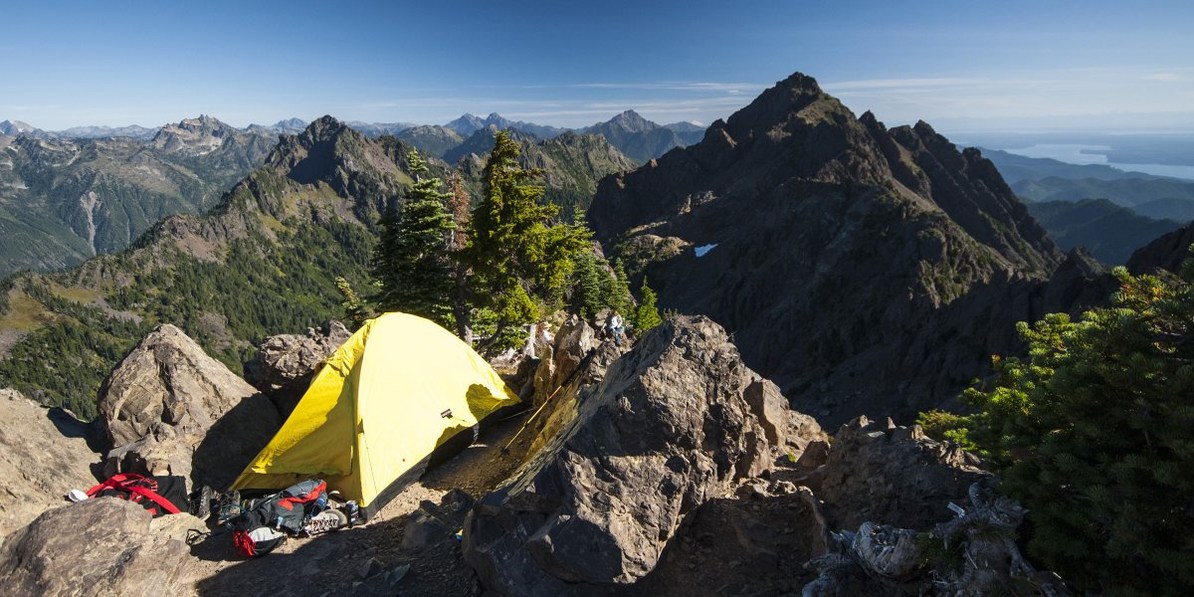
View north from the summit of Mount Ellinor. Photo by Tyson Gillard.
According to the National Park Service, "this area was first called the staircase in the 1890 diaries of the O'Neil Expedition. A 'staircase' was the only possible route up certain slopes." His route took him up the Skokomish River, over First Divide, down into the Duckabush Basin, and west over Marmot Lake and back down into the Quinault River Valley. Here, on the far northwest end of Lake Cushman, visitors can follow O'Neil's historic footsteps into a deep river valley and climb switchback trails to subalpine lakes. Notable adventures include:
- Staircase Rapids Loop Trail (2.2-mile loop)
- First Divide via North Fork Skokomish Trail (26 miles there-and-back, 3,890-foot elevation gain)
- Flapjack Lakes Backpacking (15.0 miles there-and-back, 3,200-foot elevation gain)
- Four Stream Trail (4.8 miles there-and-back)
- Wagonwheel Lake Hike (5.8 miles there-and-back, 3,200-foot elevation gain)
- Mount Ellinor (3.2 miles there-and-back, 2,340-foot elevation gain)
- Dry Creek Trail (3.0 miles there-and-back)
- Camping: Staircase Campground
- Overflow Camping: Big Creek Campground, Skokomish Park North Camp, Skokomish Park South Camp, Lake Cushman Resort + Campground
- Lodging: Lake Cushman Resort
Campgrounds and Lodging
To get a complete overview of all the camping on the peninsula, view our Complete Guide to Camping in Olympic National Park.
Lodging
- Located north of Queets in the Hoh Rainforest, Kalaloch Lodge offers year-round accommodation in a main lodge as well as in cabins. Dogs are allowed in designated rooms. Wi-Fi is unavailable, and cell service is spotty at best. Reservations can be made on the lodge's website.
- Open late April through December, Lake Crescent Lodge overlooks the lake and is right off of Highway 101. Although they must be kept on leash at all times, up to two pets are allowed in designated rooms. Dining is offered at the lodge, and Wi-Fi is accessible from the lobby. Reservations can be made on the lodge's website.
- The Log Cabin Resort is located on the other side of Lake Crescent from Lake Crescent Lodge, although their season is shorter, running from late May until late September. Pets are allowed in designated rooms. Breakfast, lunch, and dinner are available from Sunnyside Cafe. Wi-Fi is accessible from the lobby only. Reservations can be made on their website.
- Sol Duc Hot Springs Resort is open late March until late October and is located in the Sol Duc River Valley. Up to two pets are allowed in designated rooms, and they must be kept on leash at all times. Dining is available at Springs Restaurant, and a small grocery store is open daily. Reservations can be made on their website.
- Other lodging options, including home rentals, hotels and B&Bs, are readily available in the towns encircling Olympic National Park: Port Angeles, Hoodsport, Quinault, and Forks.
Backpacking, Shuttles, and Climbing Mount Olympus
Wilderness Camping Permits are required for all overnight backcountry adventures and should be reserved and purchased well in advance of your trip. However, 30% of all campsite permits are kept aside for same-day purchase. They are sold on a first-come, first-served basis for last-minute planners. Permits can be purchased and picked up at the following ranger stations:
- Olympic National Park Visitor Center, Port Angeles, 360.565.3100
- Lake Quinault Forest Service Ranger Station, 360.288.0232
- Staircase Ranger Station, 360.877.5569
Due to the extensive length of so many hikes within the park, shuttling is often necessary. If you don't have two cars, you can hire shuttles to drop you off at your trailhead so that you can pick up your car at your end destination. All Points Charters & Tours offers shuttle services for hikers at roughly $150 for six people. Call 360.460.7131 for details.
Mount Olympus is accessed via the Hoh River Ranger Station, and it is a 15.1-mile hike to Elk Lake Camp and an additional 2.3 miles to Glacier Meadow Camp (base camp). From Glacier Meadow it is 5 miles and 3,800 feet of elevation gain to the summit (West Peak). Special climbing permits are not required, but Wilderness Camping Permits for both camps should be reserved well in advance.
Pets
Dogs and pets are permitted within the park's developed areas and within all established campgrounds, but they must be kept on leashes at all times. Dogs are not permitted, however, on any of the trails or any undeveloped areas.
Logistics + Planning
Current Weather: Powered by Dark Sky








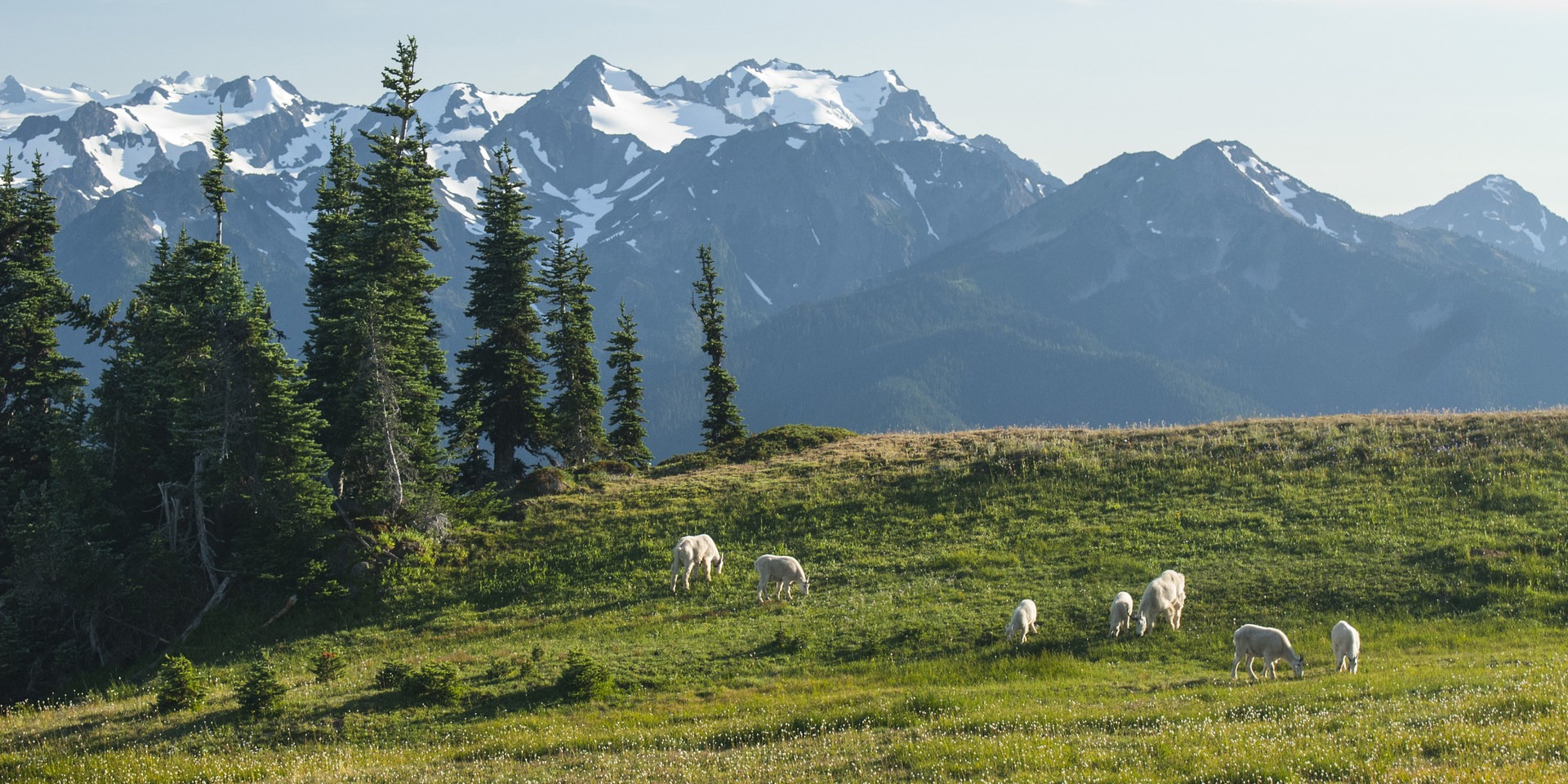


















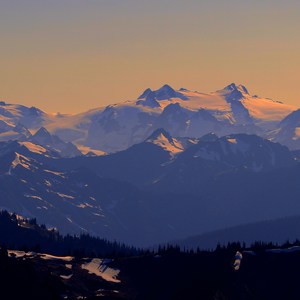
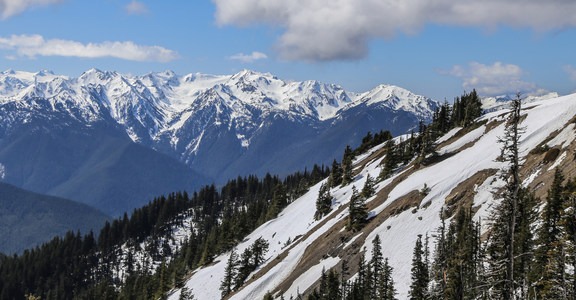
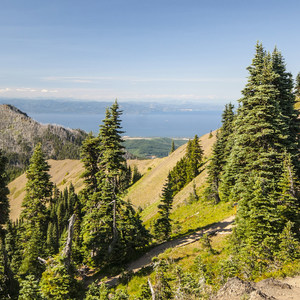
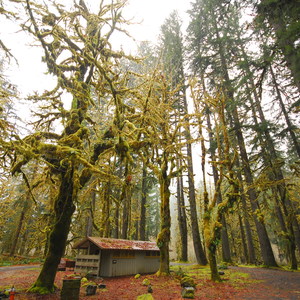
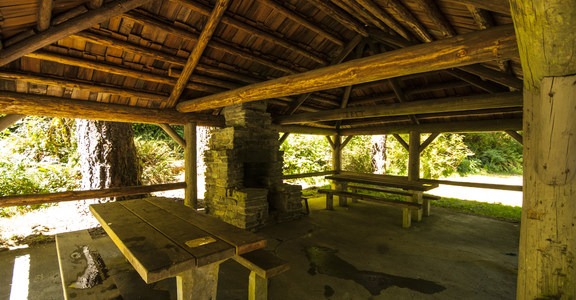
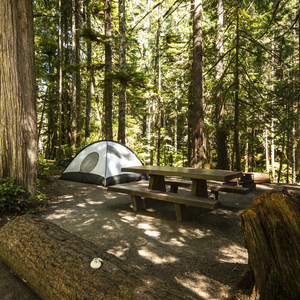



Comments
Sign In and share them.